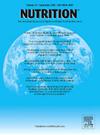肌肉组成和功能的差异:探索 CT 解剖点和 SARC-F 成分
IF 3.2
3区 医学
Q2 NUTRITION & DIETETICS
引用次数: 0
摘要
目的 我们的研究旨在:1)调查肌肉参数与 SARC-F 各组成部分/问题之间的差异;2)利用从癌症患者计算机断层扫描(CT)中获得的各种地标,探讨 SARC-F 评分与这些肌肉参数之间的关系。采用 SARC-F 问卷作为肌肉功能的替代指标,得分≥4 分表示肌肉功能较差。通过 CT 测量的肌肉评估是在腹部区域的第三腰椎(L3)水平、大腿区域和第二骶椎水平的总臀部区域使用单个横截面图像进行的。对所有解剖标志物的骨骼肌(SM)横截面积、SM指数(归一化为身高2)和SM放射密度(SMD)进行了评估。结果 本次分析共纳入了128名患者(53.1%为女性,61.7%为老年人)。SARC-F评分≥4分的患者在所有评估的地标的SMD值都明显较低。那些报告在力量(P = 0.039)、行走需要帮助(P = 0.033)和爬楼梯(P = 0.012)方面有困难的患者在 L3 地标的 SMD 值明显较低。在臀部和大腿水平,只有爬楼梯有困难的患者(P = 0.012)的 SMD 值明显较低。只有臀肌水平的 SMD 与 SARC-F 评分独立相关(β调整后 -0.09,95% CI -0.16 至 -0.02)。本文章由计算机程序翻译,如有差异,请以英文原文为准。
Differences in muscle composition and functionality: Exploring CT anatomical points and SARC-F components
Purpose
Our study aimed to 1) investigate the differences of muscle parameters in relation to each SARC-F component/question; and 2) explore the relationship between SARC-F score with these muscle parameters using various landmarks derived from computed tomography (CT) scans of patients with cancer.
Methods
This study is a cross-sectional analysis of a cohort comprised of consecutive patients with cancer, displaying CT scans. SARC-F questionnaire was utilized as a proxy for muscle functionality, with a score ≥4 indicating a poor status. Muscle assessment via CT measurements was performed using single cross-sectional images at the level of the third lumbar vertebrae (L3) in the abdominal region, the thigh region, and the total gluteal region at the level of the second sacral vertebrae. Skeletal muscle (SM) cross-sectional area, SM index (normalized to height2), and SM radiodensity (SMD) were evaluated for all anatomical landmarks.
Results
A total of 128 patients were included in this analysis (53.1% females, 61.7% older adults). Patients with SARC-F scores ≥4 demonstrated significantly lower values of SMD across all landmarks assessed. Those reporting difficulties related to strength (P = 0.039), requiring assistance in walking (P = 0.033), and climbing stairs (P = 0.012) exhibited significantly lower SMD values at the L3 landmark. At gluteus and thigh levels, only patients experiencing difficulty climbing stairs (P = 0.012) showed significantly lower values of SMD. Only SMD at gluteus level was independently associated with SARC-F score (βadjusted –0.09, 95% CI –0.16 to –0.02).
Conclusions
Our findings suggest that individuals with poor muscle composition may experience a higher risk of sarcopenia/poor muscle functionality.
求助全文
通过发布文献求助,成功后即可免费获取论文全文。
去求助
来源期刊

Nutrition
医学-营养学
CiteScore
7.80
自引率
2.30%
发文量
300
审稿时长
60 days
期刊介绍:
Nutrition has an open access mirror journal Nutrition: X, sharing the same aims and scope, editorial team, submission system and rigorous peer review.
Founded by Michael M. Meguid in the early 1980''s, Nutrition presents advances in nutrition research and science, informs its readers on new and advancing technologies and data in clinical nutrition practice, encourages the application of outcomes research and meta-analyses to problems in patient-related nutrition; and seeks to help clarify and set the research, policy and practice agenda for nutrition science to enhance human well-being in the years ahead.
 求助内容:
求助内容: 应助结果提醒方式:
应助结果提醒方式:


